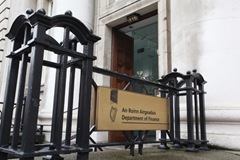Ireland, the €uro & the economic crisis
 Ireland’s underlying development strategy is as sound today as it was prior to joining the euro-zone, says economist Dr John Bradley.
Ireland’s underlying development strategy is as sound today as it was prior to joining the euro-zone, says economist Dr John Bradley.
Just as the Celtic Tiger economy of the 1990s gave rise to a media industry explaining, ex-post, how it all came about, its demise has also spawned a cacophony of racy, ex-post exegesis. A common characteristic of boom and bust is that commentators are wise after the event, but seldom before. ‘The Pope’s Children’ (2005) was filled with praise for the new Irish entrepreneurial class and hardly hinted at unsustainability. ‘The Generation Game’ (2008) told us that the Irish property market had tanked after it was the subject of disquiet even in the iconic Irish Times property supplement. ‘Follow the Money’ (2010) fingered bankers and developers as villains well after the rest of the country had woken up.
In the run-up to Ireland’s decision on joining the euro-zone in the mid-1990s, arguments for and against focused on the shifting trade orientation of the economy as its former dependence on the UK market declined and the importance of EU and other markets grew. There was no overwhelming case for or against joining the euro-zone on the basis of narrow, cost-benefit economic calculus. The strategic positioning of Ireland as a home for foreign firms trading into the expanding EU market was the deciding factor to join and formed a backdrop to the sustainable growth of the economy during the 1990s. The foreign sector boomed, domestic manufacturing restructured, and spillover into the mainly non-traded service sector generated an unprecedented growth of jobs.
The long-term Irish strategic euro call was the correct one at the time. But in the aftermath of the property bubble of the 2000s, the non-existent bank regulation and the strategic errors in government finances, this wisdom is now being questioned with hindsight. In the media, the euro zone is being blamed for creating the Irish crisis, and then for exacerbating it by offering bail-outs at too high a price. The sustainable investment-driven gains of the 1990s are confused by many commentators with the completely unsustainable building bubble economy of the 2000s. And it is not just failure of analysis by economists in the ESRI, the Department of Finance and the Central Bank that are being fingered, but also their utter inability to make their voices heard and their warning heeded by policy makers who were bent on driving the economy over a precipice.
Of course, Ireland was in good international company. Alan Greenspan’s biography, ‘The Age of Turbulence: Adventures in a New World’ (2007) displayed an arrogance of judgement and a lack of understanding that were echoed unthinkingly by Irish policy makers. And when the global financial crisis hit, with the bail-out of Bear Stearns on 16 March 2008 and the failure of Lehman Brothers on 13 September 2008, even EU policy makers were confronted with fault lines in the architecture of the euro-zone that had never been envisaged by the ‘One Market, One Money’ analysts of 1990.
Our wake-up call came when a justifiably exasperated Manuel Barosso rounded on the [former] Irish MEP Joe Higgins, and told the brutal truth: “To the distinguished member of this Parliament who comes from Ireland, who asked a question suggesting that the problems of Ireland were created by Europe, let me tell you: the problems of Ireland were created by the irresponsible financial behaviour of some Irish institutions, and by the lack of supervision in the Irish market”.
 What does the future hold? Between 1985 and 2000, Irish GDP per head grew from 67 per cent of the EU average to 115 per cent. No economist, including myself, predicted such a dramatic turnaround. With hindsight we now recognise that success came, not overnight, but as a result of decades of strategic policy decisions in the areas of education, training, improved infrastructure, policy stability, transparency in corporate taxation and the willingness of households to carry a correspondingly higher tax burden. Many of the gains of these years have now been dissipated both in terms of lower current income and higher national debt. However, the underlying Irish development strategy is as sound today as it was at the height of the 1990s Tiger period.
What does the future hold? Between 1985 and 2000, Irish GDP per head grew from 67 per cent of the EU average to 115 per cent. No economist, including myself, predicted such a dramatic turnaround. With hindsight we now recognise that success came, not overnight, but as a result of decades of strategic policy decisions in the areas of education, training, improved infrastructure, policy stability, transparency in corporate taxation and the willingness of households to carry a correspondingly higher tax burden. Many of the gains of these years have now been dissipated both in terms of lower current income and higher national debt. However, the underlying Irish development strategy is as sound today as it was at the height of the 1990s Tiger period.
To grow out of our present crisis, we first need to face into the consequences of our past policy mistakes and implement institutional and other safeguards that will minimize prospects of future policy- induced economic catastrophes. Blaming the rest of the world for our own errors is ridiculous and a luxury that we can ill afford.





